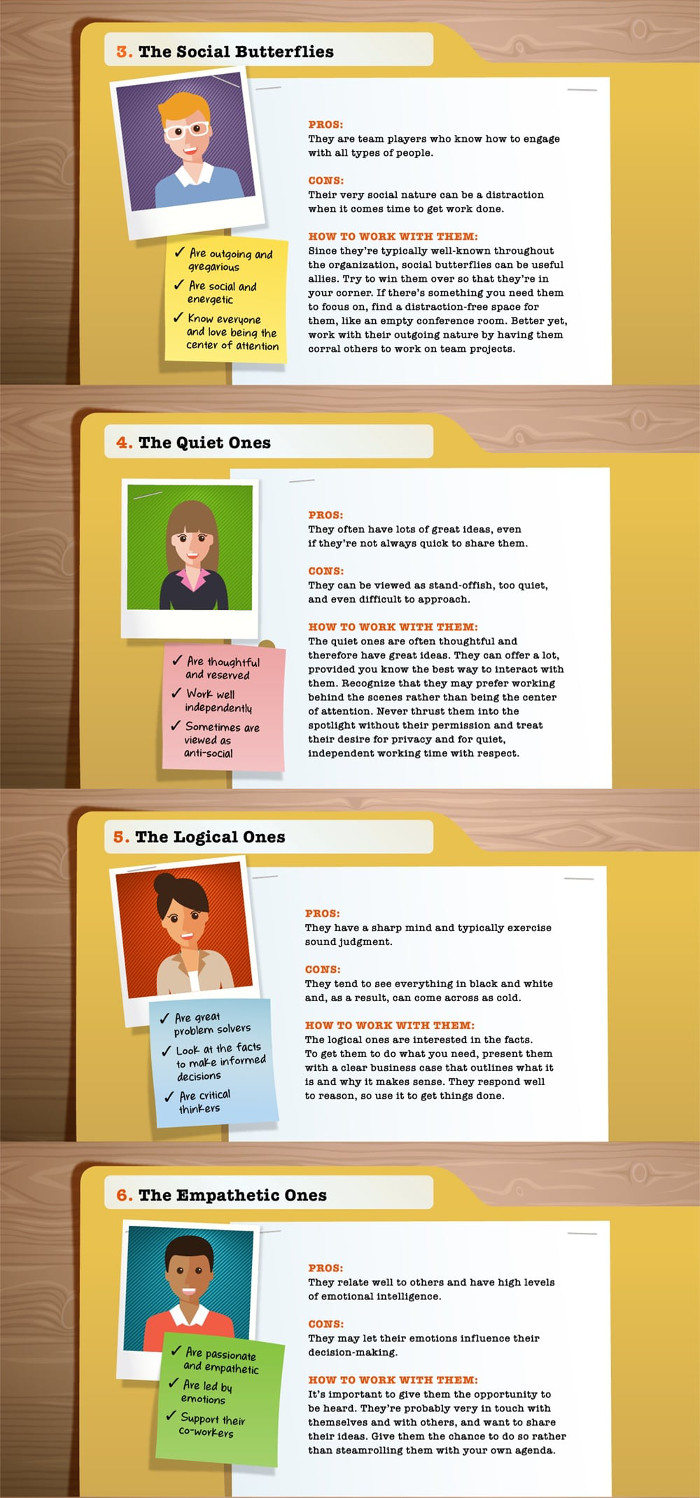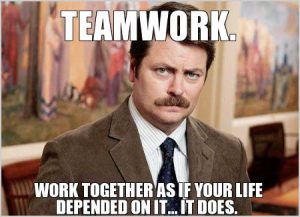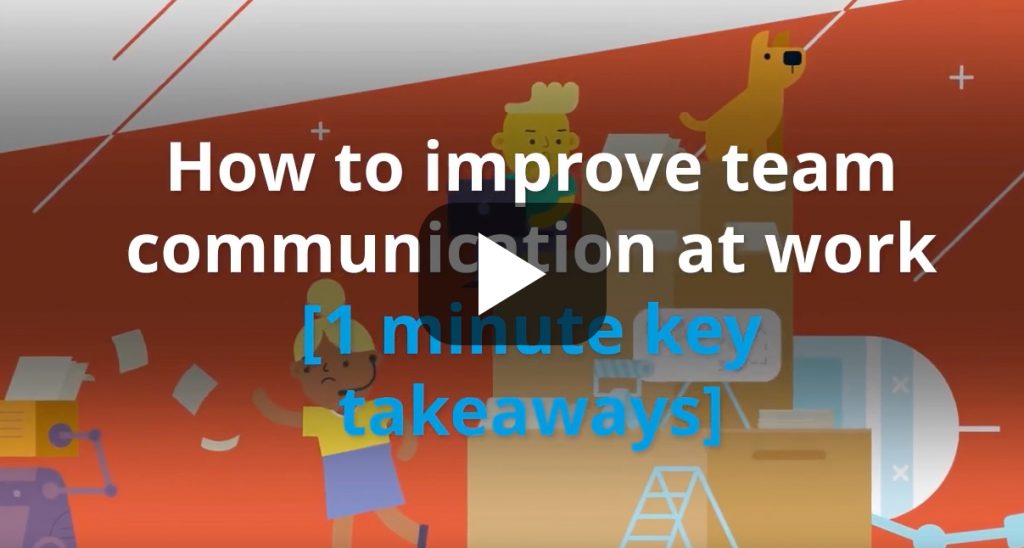“We have communication issues.”
You’ve probably heard this one a million times as an excuse for many things. Be it unfinished work, employees who are in a bad mood, poor teamwork, or something else, this sentence pops up quite a lot. If you take a look at some surveys, poor team communication is one of the biggest reasons for problems at work.
But what does poor communication mean for you?
When communication is poor, deadlines don’t get met. Starting projects is difficult. Ideas are not discussed properly. Employees don’t give their best at work. Conflicts happen more often than not. And this is just the tip of the iceberg.
Imagine a situation where the nurse doesn’t tell the doctor which leg she should operate on. Or a co-pilot not telling the pilot about the damage to one of the airplane engines.
Whether it’s over-communication under-communication or something in-between, it influences the way your team works. Improving team communication can resolve many of these issues. We’ve done quite a bit of research and we came up with this massive list of 50 ways to communicate better with your team.
Let’s get started – we hope you find at least a few tips that you can use with your team!
Onboarding new employees
When a new employee joins your company, they are probably super excited to get started and kick off their new role successfully. However, they are also pretty stressed at the same time. They are nervous as they get to see their new workplace and team for the first time and start communicating with them.
69% of employees are more likely to stay with a company for three years if they experience great onboarding.
We all know how it feels to be the new guy or girl in the group, be it in school, at work, or somewhere else. It’s exciting to meet new people, but it can also be challenging to communicate. There are a few ways to make the onboarding process easier for the new hire.
- Properly introduce them to their new colleagues. Make a video introducing the new hire and announce them publicly, don’t keep it a secret.
- Send an email to everyone in the company and tell them that someone new is joining. Tell your team a little bit about the new hire.
- Give the new employee a nameplate on their desk or door, and order them some business cards.
- Give them access to internal company knowledge or documents. That way, they can get accustomed to how you work and communicate.
If you want to save time for new hires, make sure to create an onboarding checklist that you can reuse later on.
Celebrating workplace diversity
Nowadays, it’s not unusual to work in a team where everyone comes from different cities, countries, or even continents. Our team at Chanty has a few employees who work from home in different parts of Europe. Working with people from diverse backgrounds provides a rich pool of ideas, perspectives, and experiences that enhance the creativity and problem-solving abilities of a team. The important thing to remember is that different cultures have different ways of understanding things and giving feedback.
For example, a project manager in Boston tells a developer in Brazil to finish something soon. The problem is, that their idea of “soon” can be much different. While “soon” may imply urgency in one culture, it might signify a more relaxed approach in another. This can lead to misalignment and frustration if not addressed. Languages and cultures can attribute different meanings to terms we all take for granted.
It’s also very common nowadays to have people who work with you but don’t speak your language, so you’ll have to use a common one like English.
“Language barriers were listed as a reason why 40 percent of global virtual teams were not successful.
However, you can also improve communication in a culturally diverse workplace.
- Offer language learning classes to help employees learn how to communicate with each other better.
- Don’t overuse idioms, slang, or professional jargon when talking to non-native speakers. Keep your language simple and easy to understand.
- Ask someone who speaks both languages to explain your thoughts better to a non-native speaker.
- Hang around with people from different cultures! People from the same country often stick together – try to avoid this and talk to everyone in the workplace.
Using psychology: define who is who
You have probably taken one of those strange personality quizzes that tell you what type of burger or font or Pulp Fiction character you are. Admit it, there is some satisfaction in knowing you are more of a Vincent Vega than a Marsellus Wallace.
Some of these tests might be silly, but the reason we are interested in them isn’t. That knowledge can help you to know how to work better with your teammates — that is something crucial for building and working on successful, productive teams. There are some personality tests you can try out:
- Big Five Personality Test
- Jung Typology Test
- The “Rorschach” test
All employees have their own identity. Managers have to deal with a variety of different temperaments in the workplace. So, how can you benefit from having different personalities in your teams? Create the right mix of employees’ characters and help them interact the right way.



- Create teams with mixed personalities. Your workplace will be more stable and your communication more effective.
- Recognize that some employees are dominant and others are more introverted, but everyone can contribute something. This is why you need to make sure that everyone participates in meetings and discussions.
- Recognize the value of all personality types. Just because someone acts differently, it doesn’t mean that they can’t contribute to your organization. If you choose the right management style, you can combine different personalities in the workplace.
Different employees will require different approaches. You need to be informed about different temperament types and how to work with each of them effectively. That way, you’ll communicate better with everyone as a leader and your team will be more coherent and successful.
Brace yourselves, feedback is coming
Without feedback, the best that you can hope for is to reach your goals by accident. At worst, you’ll wander, not knowing if you did something right or wrong. If you want to create an effective feedback mechanism at work, pay attention to the following.
- Have an open-door policy
One of the biggest problems that employees have in the workplace is communication issues with their managers and CEOs. They will feel uncomfortable getting in touch, so they will avoid communication completely.
Try introducing an open-door policy where employees can approach you and bring something to your attention when they feel like it. Everyone wins in this situation.
13. Offer a platform for anonymous feedback
Let your employees leave their opinions by sending them an anonymous employee survey or allowing them to use an anonymous suggestion box.
Become a meeting sensei
Why are unproductive meetings happening all over the place? One of the reasons is that not everyone knows the cost of a meeting. Consider this quote from the book ReWork by Jason Fried and David Heinemeier:
Let’s say you’re going to schedule a meeting that lasts one hour, and you invite ten people to attend. That’s a ten-hour meeting, not a one-hour meeting. You’re trading ten hours of productivity for one hour of meeting time.
How does that sound?

giphy.com
On the other hand, we can’t neglect the fact that meetings are the #1 way to collaborate – you can’t just give up on meetings altogether. However, there are some ways to make them more efficient and to promote effective communication within teams.
- Have a clear agenda for every meeting – who speaks about what and when.
- Set a timer and end the meeting when it runs out. We don’t hold meetings longer than 30 minutes; 15 minutes is even better.
- Invite as few people as you can.
- Invite only the people who are relevant to the issue being discussed.
- End each meeting with a clear result and make someone responsible for making it happen.
- Hold regular one-on-one conversations besides meetings. That way, the management will understand the employees better and vice versa.
You can also get a nice communication tool for your team, letting you discuss plans, assign tasks, and handle all communication and collaboration from one place. That way, you can effectively decrease the number of meetings you hold.
Get some proper communication tools to streamline and simplify communication in teams.
20. First, don’t use emails only to communicate.
Maybe you love emails, but you need to give another communication method a try. Employees tend not to read emails and they often miss them, ignore them, or delete them without replying.
- Get a team communication app
We’re huge on team communication apps – you can tell by the tool that we are building. We are not alone – there are lots of communication tools out there today. The reason they are so popular is that they simply enhance communication.
Imagine a scenario where a coworker sends you an important link for work. You try to remember where they sent it and you’re stuck for hours. Was it Viber, Messenger, Skype, email, or something else? And are you even sure it’s that coworker who sent it or someone else?
Our main reason for using a team communication app is to have all of our most important communication in one spot. Keeping track of emails and conversations in different apps quickly became tiring so we just switched to using one app for work instead.
Not only do you have all of your communication in one place, but you can also easily find all of your work files. Moreover, you can access everything, everywhere. Finally, team chat apps nowadays have lots of features that can boost your team’s productivity. For example, Chanty allows you to turn messages into tasks within the app.
- Make room for emotional conversations
When it comes to communication at work, informal conversations are more important and more difficult than you think. You can use your team chat apps for water cooler moments and talk about things unrelated to work in designated channels. If you work in a remote team, this type of communication is especially important.
- Get an online project management tool
Collaboration is at the heart of good team communication. The good and bad news is that there are lots of online PM tools that help you with your team communication. You can use them to track progress for your tasks so that everyone is on the same page. These tools help you document all of your work easily.
Every obstacle in the project lifecycle is the potential for chaos. A survey found, that when organizations become better at project management, the KPIs increase significantly, and productivity can improve by over 60 percent.
At some point, you’ll realize that you can’t manage everything with spreadsheets and this is when you start using project management tools. These tools will help you save time and collaborate effectively with your team.
Here are some of the many benefits of using project management tools:
– Planning and forecasting
– Progress tracking
– Constant access to all apps in real-time
– Security
If you can’t manage your projects with spreadsheets and emails, try a project management tool instead.
Don’t forget about motivation
Some companies fail to understand the importance of employee motivation.
According to Gallup’s most recent survey on this topic, “State of the American Workplace”
70 percent of employees lack engagement on some level. That’s estimated to cost the U.S. a whopping $450 billion to $550 billion in lost productivity per year.
On the contrary, motivating employees can lead to increased productivity and allow an organization to achieve higher levels of output.
- Identify a common goal
Within every company, be it an advertising agency or a B2B2C eCommerce store, there are common goals, which can depend heavily upon the business focus. Identifying and clarifying common goals can have several benefits. After all, there is nothing more important for a team than each member having a similar mindset.
- Make the mission and vision clear
Take the time to explain the company values and mission, whether as part of corporate training or as a regular reminder to employees. When employees are consolidated in their understanding of the company goals, they will be able to communicate with one another more effectively in order to reach them.
Take inventory of your communication skills
Every employer wants their workers to communicate, but what about your own communication skills? If you want to serve as a model leader, the only way to do so is through self-development. Improving your own communication skills lays the foundation for better team communication, which leads to improved collaboration and increased productivity.
- Ask questions
No matter what type of company you run, every employee perceives things in their way. If you ask your employees how they want to communicate, you can create a better communication plan for your organization. Moreover, your employees will love the fact that you’re considerate enough to inquire.
- Give your undivided attention
If you’re having a conversation with someone and they keep checking their phone or looking elsewhere, you won’t be in the mood to keep communicating. Maintain eye focus as much as it’s acceptable and polite and put everything else aside to show the other person that you are attentively listening.
- Take time to listen
There is more than one person that needs to talk in a conversation. If you’re the one speaking all the time, people will start tuning you out and nothing you say will come through. Take a break sometimes to let others chime in. That way, other participants in the conversation will feel like they are actively participating too.
- Be mindful of how you are communicating
Mindful communication is more than words. Pay attention to your posture, facial expressions, and body language. Rest your arms instead of crossing them over your chest – this is interpreted as a sign of defense. Smile when it’s appropriate, nod your head while someone else is talking, and establish eye contact.
- Follow up in writing
No one remembers everything that takes place in a meeting. Make a few short notes about the meeting and send them in an email to whoever needs to be informed.
- Inform and inspire
This is easier said than done, but try to inspire your employees to take action in your communication efforts. If you can’t manage this on your own, you can hire a mentor or a coach.
- Make it two-way
If you give feedback to your employees, make sure to request it from them too. As mentioned earlier, they may be too scared to give honest feedback, so you can make the system anonymous to get more honest answers.
33. Keep it face to face
Team communication apps like Chanty are the most efficient and fastest way to get in touch. However, seeing your coworkers face to face improves sincerity and authenticity in your communication.
- Don’t over-communicate
There is a fine line between sending a good amount of emails and blowing up someone’s inbox. Especially after the workday is done, don’t send countless emails to your coworkers because it can wait until the morning.
- Never personalize criticism
If you’re criticizing someone or you’re being criticized, always remember to focus on the action being done and not the intent that someone has. You can never really know what someone intended to do before they’ve taken the action. Give and accept criticism without involving emotion whenever you can.
- Give compliments in a thoughtful way
If you compliment a colleague on a job well done, she may be left wondering what exactly she did right. Be specific about your feedback – if someone does something well (or poorly), tell them what they specifically did to deserve your feedback. Your employees will know which direction to take the next time they do a similar task.
- Take suggestions in earnest and explain why when you can’t
Always accept all suggestions that come your way and make your coworkers feel like their voices are heard. However, don’t be afraid to reject the bad ones, but do come up with reasons why they are rejected.
Team building is a big deal
If you want to improve the way your team works, you should incorporate some form of team building. There are lots of team-building activities that you can try, indoors or outdoors. You can have cooking classes, music events, language learning, team building games, trips to adventure parks and petting zoos, or even prank your co-workers and whatever else comes to mind. Here are a few of our favorite team-building methods.
- Get outside the office
If you stay indoors for too long, it can have negative psychological effects on everyone. Sometimes, you can make an amazing change just by going outside for a bit. Contrary to popular belief, if you are outside, it does not always imply that you are not working. You can just move to a different spot where you can work together on a project. For example, our marketing team meeting is always in a nearby café – it’s just more fun that way.
- Schedule a work retreat
Instead of working all the time, you can take a day or two to let your team get to know each other more. A work retreat is an excellent way to do this and it doesn’t require a mind-blowing budget either, because you can visit places as close as an hour away from the office – it’s not necessary to go to a different continent.
- Attend conferences as a team
Consider this as a double win – you get to attend a conference and learn something AND spend some time with your team. Once again, conferences don’t have to be expensive – you can find local ones that won’t break the bank.

- Allow watercooler chat
Many employers dislike it when employees talk about non-work stuff in the office. However, this is not a waste of time – it’s an excellent way to foster great communication. Encourage employee chit-chat whenever possible, so your team members can learn more about each other and communicate more effectively.
- Celebrate your employees’ achievements.
If someone does great work, they should be recognized and awarded. Perhaps you can’t give them a raise, but you can give them something just as precious – your time. Take time off your day to show your employees that you appreciate their hard work, and always make sure to do it publicly in front of the whole team.
- Identify and reach out to shy employees
We all have different personalities and some people are shy by nature. Instead of attempting to change them, acknowledge their character traits, and help them express themselves more. Show them genuine interest and encourage their comments and thoughts so that they too contribute to workplace communication in all shapes and forms. Remember that this may take a while, depending on their personality.
- Focus on company culture
This is another one of those things that is easier said than done. Company culture is a set of values that you believe in, something that sets you apart not just from the competition, but from all other companies out there. For us, company culture is all about togetherness, transparency, and open communication. If you have the time, sit down and document what work means to you and the philosophy behind the way you work.
- Encourage cross-departmental education
Wouldn’t it be great if someone from marketing could learn about sales? And someone from development could learn more about product marketing, for example. If you let your employees learn from each other (and encourage it), people will be able to see why certain decisions are made and they can get a better overview of your company, service, or product. You never know, your sales representative just might become your next marketing team member too.
Thinking outside the box when it comes to office space
People need comfortable spaces to work in. You cannot expect great results if you surround your team with an environment that makes them uncomfortable or unhappy.
Investment in ergonomic furniture and effective use of space could increase productivity by up to 64%.

- Rearrange your office
You don’t have to buy new furniture to do an office makeover. Many offices today are set up traditionally, with employees separated by cubicles and walls. Removing these obstacles is a good way to get started on rearranging your office for better organizational communication.
47. Respect the need for silence
Some people perform well in noisy environments, others need a quiet place to do their best work. In any case, we all need a quiet room when we need to have a meeting or a spot where we can unwind and relax. Try to create a separate room or corner in your office with absolute silence so your team members have a choice when they want to get some peace.
48. “Hot desking” experiment
There is something called “hot desking” where no one in the office works at the same desk all the time. That way, people can switch around depending on the person they need to collaborate with during that day. This is not always easy to pull off, but it’s a great way to get your team to communicate more with everyone.
- Use a single coffee machine
There is a famous story of a company that had a single coffee machine for an entire building that worked together – and they achieved amazing results. It’s simple – having a single coffee machine forces people to communicate more.
- The white wall room technique
A white wall room is not necessarily a room with white walls. It’s a room where everyone can come up and use a whiteboard to try and solve a problem. Everyone from every team should have access to this room so they can discuss the problem together and suggest solutions so those problems can be solved.
Besides communication, we use whiteboards in our office for teamwork and collaboration. We have one whiteboard for tasks – when a task is done, we delete it. On the second whiteboard, we write down task details when we have something overwhelming and complex. That way, one board is for ticking off tasks, and the other one is there if we have a complicated task that needs clarification. It may sound complicated, but it’s actually very simple and it’s incredibly satisfying to watch finished tasks disappear in front of your eyes.
The integration of visual aids, such as ready-to-use graphic templates for brainstorming sessions or even presentations can be remarkably effective in the creation of a welcoming workplace culture and fostering open communication.
One bonus tip: tables that fold into walls
You never know how many people you may need to get a job done. Sometimes, you may need an extra table for an extra set of hands and in these situations, foldaway tables can be of great help. They don’t take extra space and they’re there when you need some extra space for your gear.
When you’re working with a team, extra space can do wonders for enhancing team communication. It’s not just about clearing the clutter – it’s about giving everyone a spot to gather and exchange ideas without feeling cramped. Foldaway tables allow you to create flexible, dynamic spaces that adapt to your team’s needs. This way it’s easier for your team to stay connected and collaborate smoothly, no matter the task.

Conclusion
We hope that you enjoyed reading this article as much as we enjoyed writing it! This list of 50 great ways to improve communication and collaboration at work is a product of our own experience and desire to improve the way we work at Chanty. Effective team communication is essential to fostering a positive working environment and increasing productivity. By implementing these strategies, you can significantly improve team communication and pave the way for more effective collaboration. We sincerely hope that you find it useful and that you can apply at least a few of these tips in your workplace. If you have any other tips that we should know, please let us know in the comments below! 😉
This article was originally written in 2017 and updated in 2025.










Add comment